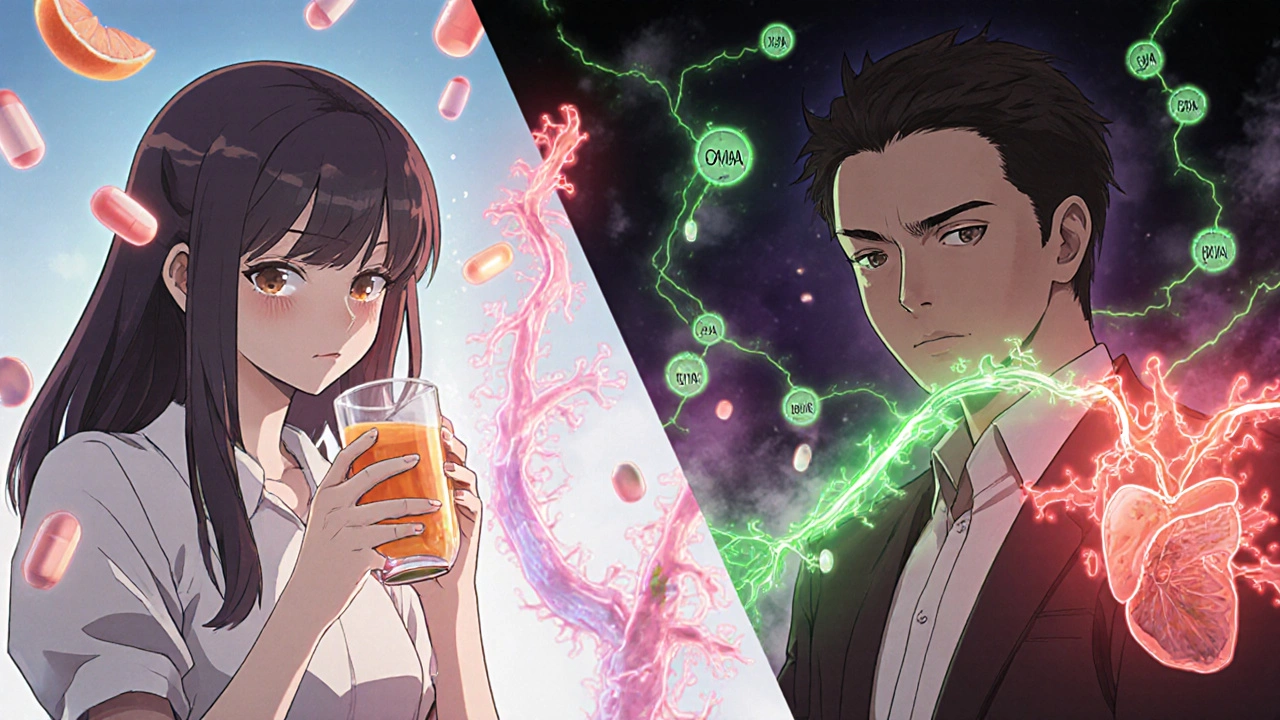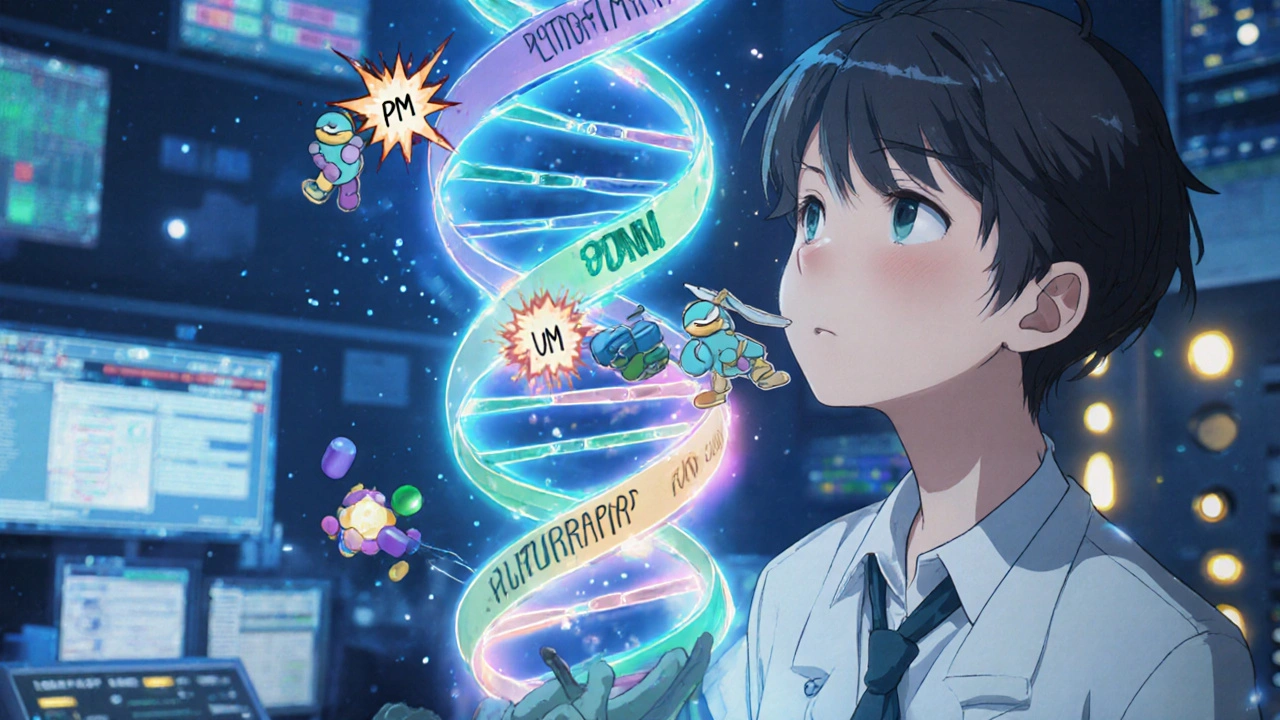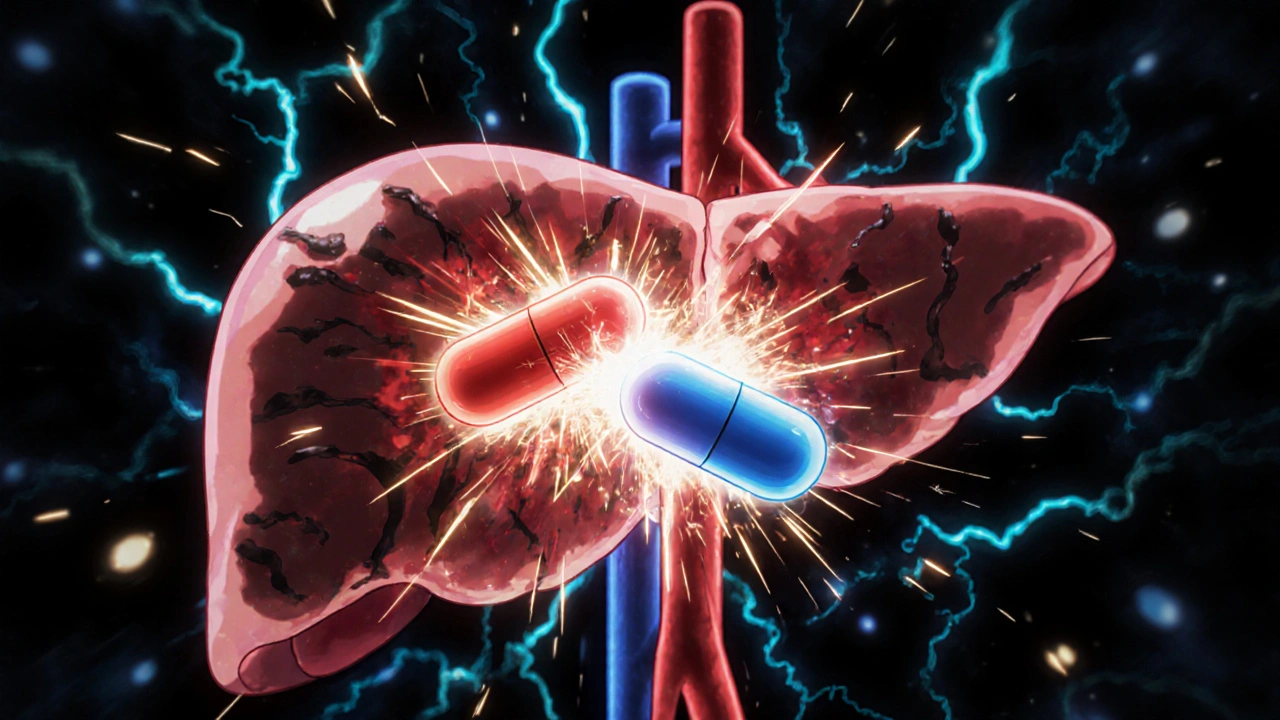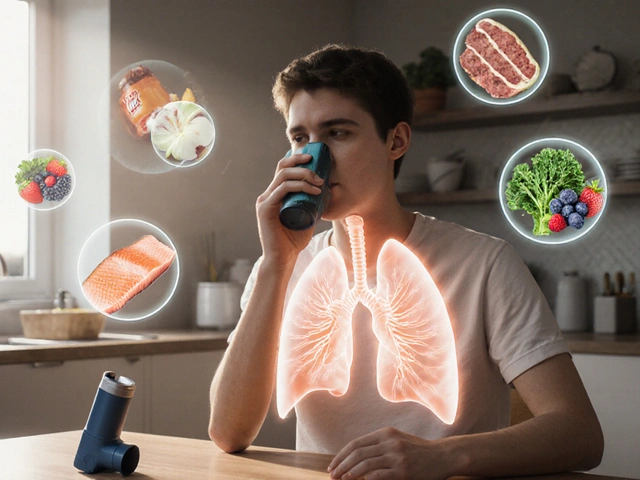CYP450 Drug Interaction Checker
How it works
Check for potential interactions between medications that compete for CYP450 enzymes. Select up to 4 medications and see if they might interfere with each other's metabolism.
Potential CYP450 Interactions Found
Imagine taking two pills at the same time - one for your blood pressure, another for depression - and not realizing they’re fighting over the same metabolic pathway in your liver. One drug gets stalled, the other vanishes too fast. The result? A dangerous spike in side effects… or no pain relief at all. This isn’t science fiction. It’s happening right now in millions of people because of how drugs compete for space on the CYP450 enzymes.
What Are CYP450 Enzymes and Why Do They Matter?
CYP450 enzymes are your body’s main drug-processing crew. They live mostly in your liver, with a smaller team in your gut, kidneys, and lungs. These enzymes break down about 90% of all prescription medications so your body can flush them out. Without them, drugs would build up to toxic levels. But here’s the catch: they’re not infinite. There are only so many slots available, and when two drugs show up at once, they fight for access.
The big players? CYP3A4 handles half of all drugs - statins, opioids, blood thinners, and immunosuppressants. CYP2D6 takes a quarter, mostly psych meds like antidepressants and beta-blockers. Then there’s CYP2C9 for warfarin, CYP2C19 for clopidogrel, and CYP1A2 for caffeine and theophylline. These six enzymes do 90% of the work. The rest? Kidneys or sugar attachments. Simple. Clean. But CYP450? It’s messy, crowded, and easily thrown off.
How Do Drugs Compete? Inhibition and Induction
There are two main ways one drug messes with another’s metabolism: inhibition and induction.
Inhibition is like someone cutting in line at the bathroom. One drug blocks the enzyme’s active site, so the other can’t get processed. This is usually quick - happens within hours. Take clarithromycin (an antibiotic) with simvastatin (a cholesterol drug). Clarithromycin jams CYP3A4. Simvastatin can’t break down. Levels in your blood jump 10-fold. Result? Muscle damage, kidney failure, even death. This isn’t rare. It’s documented in hospital case reports every year.
Some inhibitors are stronger than others. Ketoconazole? It’s a heavyweight. It can boost drug levels by 5 to 10 times. Fluvoxamine? It shuts down CYP1A2. One patient on theophylline (for asthma) had levels spike from 10 to 25 mcg/mL after adding fluvoxamine. Seizures followed. That’s not a typo. That’s a real case from Reddit’s pharmacy community.
Induction is the opposite. One drug tells your liver to build more enzymes. It’s like adding extra lanes to a highway. But that means the other drug gets cleared too fast. Rifampin (for tuberculosis) is the classic example. It can make CYP3A4 activity jump by 400-600%. If you’re on birth control, a blood thinner, or an antidepressant - your levels drop. Treatment fails. You get pregnant. Or your pain returns. This doesn’t happen overnight. It takes days to weeks. And it lingers for weeks after you stop the inducer.
Genetics: Why Two People React Differently to the Same Dose
Two people take the same antidepressant. One feels better. The other feels sick. Why? Genetics.
CYP2D6 has over 100 known variants. People fall into four groups: poor metabolizers (PMs), intermediate (IMs), extensive (EMs - the average), and ultrarapid (UMs). In Caucasians, 5-10% are PMs. That means they barely break down drugs like codeine or tramadol. Codeine needs CYP2D6 to turn into morphine. If you’re a PM? You get no pain relief. If you’re a UM? You turn codeine into morphine too fast. You overdose on your own body’s painkiller.
Same with tamoxifen. It’s a breast cancer drug that needs CYP2D6 to become active. PMs have a 30-50% higher risk of cancer returning. That’s why the FDA now recommends testing before prescribing clopidogrel - a heart drug that also needs CYP2C19. 30% of white people and 60% of Asians are slow metabolizers. Giving them the standard dose? It’s like giving them water instead of medicine.

What’s Really in Your Medicine Cabinet?
It’s not just prescription drugs. Grapefruit juice? It’s a CYP3A4 inhibitor. One glass can cut the clearance of statins by 30-80%. That’s why you see warnings on simvastatin and atorvastatin bottles. St. John’s wort? A herbal supplement for depression? It’s a powerful CYP3A4 inducer. It can tank levels of cyclosporine, birth control, and even some HIV meds. People don’t think of herbs as drugs. But they act like them.
Even common OTC meds matter. Cimetidine (Tagamet) blocks CYP3A4 and CYP2D6. It’s sold for heartburn. But if you’re on metoprolol, sertraline, or codeine? You’re increasing your risk of slow heart rate, serotonin syndrome, or opioid toxicity.
Real-World Consequences: What Happens When Things Go Wrong
Here’s what it looks like in practice:
- A 72-year-old woman on simvastatin adds clarithromycin. Within 3 days, her muscles break down. She’s hospitalized with rhabdomyolysis.
- A man on metoprolol (for high blood pressure) starts fluoxetine (an antidepressant). Both are CYP2D6 substrates. His heart rate drops to 45. He faints at work.
- A teenager on codeine for a sports injury doesn’t get pain relief. Turns out, he’s a CYP2D6 poor metabolizer. His doctor didn’t test him.
- A woman on warfarin (a blood thinner) starts taking an OTC painkiller with CYP2C9 inhibition. Her INR spikes. She bleeds internally.
These aren’t outliers. They’re routine. In fact, CYP450 interactions cause 30% of all serious adverse drug events. And in people taking five or more medications? One in five hospital admissions are linked to these interactions.

How to Stay Safe: What You Can Do
You don’t need to be a pharmacist to avoid these traps. Here’s what works:
- Know your meds. Keep a list - all of them. Prescriptions, supplements, even herbal teas. Bring it to every appointment.
- Ask your pharmacist. They’re trained to spot interactions. Ask: “Could this interact with anything else I take?” Don’t assume it’s safe because it’s over-the-counter.
- Check for genetic testing. If you’re on multiple psych meds, blood thinners, or heart drugs, ask if CYP2D6 or CYP2C19 testing is right for you. Tests cost $250-$500. Many insurers cover them now.
- Use trusted tools. Apps like Lexicomp or Epocrates flag major interactions. Hospitals use them. You can too.
- Watch for signs. Unexplained fatigue, muscle pain, dizziness, confusion, or sudden changes in heart rate? It could be an interaction. Don’t wait. Call your doctor.
The Future: AI, EHRs, and Personalized Dosing
Things are changing. Hospitals are starting to integrate CYP450 data into electronic health records. Epic and Cerner now show real-time alerts when a new prescription might clash with your current meds. IBM Watson’s AI system can predict CYP interactions with 89% accuracy. The NIH is standardizing gene names so doctors everywhere speak the same language.
By 2025, pharmacogenomic testing could become routine - not just for cancer or heart drugs, but for common antidepressants and painkillers. The goal? Give you the right dose the first time. No trial and error. No hospital visits.
But until then? You’re your own best defense. Know your drugs. Ask questions. Don’t let your meds fight each other.
Can grapefruit juice really affect my medications?
Yes. Grapefruit juice blocks CYP3A4 in your gut, which means more of the drug enters your bloodstream. This can happen with statins like simvastatin, blood pressure meds like felodipine, and even some anti-anxiety drugs. One glass can increase drug levels by 30-80%. It’s not about how much you drink - even a small amount can have an effect. If your pill bottle says "avoid grapefruit," don’t take the risk.
Are herbal supplements safe to take with prescription drugs?
Not always. St. John’s wort, for example, induces CYP3A4 and can make birth control, antidepressants, and transplant drugs ineffective. Garlic, ginkgo, and green tea can also interfere with blood thinners. Just because something is "natural" doesn’t mean it’s harmless. Always tell your doctor or pharmacist what supplements you’re taking - even if you think they’re "just vitamins."
Why do some people need lower doses of the same medication?
Genetics. About 5-10% of people are poor metabolizers of CYP2D6 or CYP2C19. Their bodies break down drugs too slowly, so standard doses build up to toxic levels. Others are ultrarapid metabolizers - they clear drugs too fast, so the medicine doesn’t work. This isn’t about weight or age. It’s about your DNA. Testing can reveal this before you even start a new drug.
Can CYP450 interactions cause long-term damage?
Yes. Repeated exposure to high drug levels can damage your liver, kidneys, or muscles. For example, chronic statin buildup from CYP3A4 inhibition can lead to permanent muscle weakness. Overdosing on opioids due to CYP2D6 inhibition can cause respiratory damage or brain injury. Even if you don’t have an acute reaction, long-term interactions can silently harm your organs.
Is pharmacogenetic testing worth it?
If you take three or more medications - especially antidepressants, blood thinners, heart drugs, or painkillers - yes. Testing can prevent hospitalizations, avoid trial-and-error dosing, and save money in the long run. Many insurance plans cover it now. The test is a simple cheek swab. Results take less than a week. For people with complex medication regimens, it’s one of the most effective safety tools available.
What Comes Next?
The future of safe prescribing isn’t just about new drugs. It’s about knowing who you are - genetically, metabolically, and medically. CYP450 interactions are avoidable. But only if you’re informed. Don’t wait for a crisis. Talk to your doctor. Ask about your meds. Keep a list. Use tools. Your body is doing its best to process everything you take. You just need to help it out.




Finally someone explains this without jargon. I was on simvastatin and clarithromycin once and thought I was dying from muscle pain. Turns out my liver was screaming. Always tell your pharmacist everything - even that herbal tea you think is harmless.
So we’re supposed to trust doctors who can’t even spell ‘CYP450’ correctly on charts? This isn’t science - it’s pharmaceutical roulette. We’ve been conditioned to believe pills are safe because they’re FDA-approved. But the system is rigged to profit from side effects, not prevent them.
Look - our bodies aren’t machines. They’re messy ecosystems. CYP450 enzymes? They’re like a crowded subway at rush hour. One guy with a giant backpack (clarithromycin) shoves in and everyone else gets squished. Some people have bigger backpacks - that’s genetics. Others just got on the wrong train. We need to stop treating medicine like a spreadsheet and start treating it like a living system. Your DNA isn’t a flaw - it’s a map. And we’re just now learning how to read it.
Typical American medical ignorance. In India, we’ve known for decades that herbal supplements interfere with drugs. You people take St. John’s wort like it’s chamomile tea. And you wonder why your antidepressants don’t work? No genetic testing? No wonder your hospitals are full. Your system is built on ignorance and insurance loopholes.
My doc gave me sertraline and then added cimetidine for heartburn. I nearly passed out. He didn’t even blink. This stuff is happening all the time and no one cares. You think your pharmacist gives a damn? They’re just scanning barcodes. Wake up.
OMG I JUST HAD THIS HAPPEN TO ME 😭 I was on warfarin and took a random ibuprofen for a headache - NEXT THING I KNOW I’M IN THE ER BLEEDING OUT. My INR was 8.8. Like… WHAT?!? They said ‘it’s common’ - COMMON?!? That’s not common, that’s a near-death experience. I’m never trusting OTC again. EVER. 🚨💊
I get how scary this is. I’ve been on five meds for years and never thought about interactions. But I started keeping a list - paper, in my wallet - and asking my pharmacist every time. It’s not about fear. It’s about being a quiet advocate for your own body. Small steps matter.
Y’all need to stop being so soft. This is why America’s dying. You take supplements like they’re candy. You don’t even know what’s in them. I’ve seen people on statins drinking grapefruit juice like it’s a health trend. Meanwhile, their kidneys are turning to mush. You want to live? Stop being lazy. Read the label. Or die. Simple.
My grandma died from a CYP interaction. She was on blood pressure meds and took that ‘natural’ garlic pill. No one told her. She just thought it was good for her heart. She didn’t even know what CYP meant. We need better education. Like, in schools. Like, yesterday.
Let’s be brutally honest - this isn’t about pharmacology. It’s about capitalism. Pharma companies don’t want you to know about interactions because then you’d stop buying their drugs. They’d have to test every combo. They’d have to warn you. They’d lose billions. So they bury the data, fund misleading studies, and let you die quietly. This post is a rare glimpse behind the curtain. Most people never see it.
I’m a nurse and I can’t tell you how many times I’ve seen this. One guy on clopidogrel took omeprazole - classic CYP2C19 inhibition - and had a heart attack 3 days later. We didn’t catch it until his wife showed us his supplement list. I now hand every patient a little card: ‘List EVERYTHING you take - even turmeric.’ I even give them a free printable template. 📋✨ If you’re on 3+ meds, please, please, please get tested. It’s a cheek swab. It takes 10 minutes. It could save your life. You’re worth it 💛